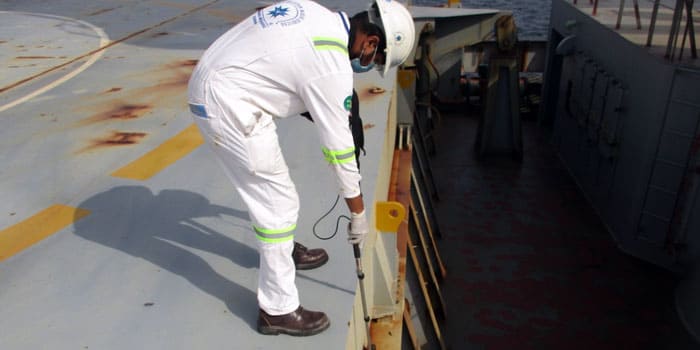Uld Inspection of Hatch Cover for Watertight Integrity Carried Out by the Master Mariner / Naval Architect From Constellation Marine Services Llc.

We, Constellation Marine Services LLC as independent ship and marine surveyors, often get instructions from our principals to carry out Ultrasonic leak detection test of Cargo Hold hatch covers for
watertightintegrity. Recently we got a nomination from one of our clients to carry out ULD testing of hatch covers on board a Bulk carrier and report on its watertight integrity. Our Master Mariner/Naval Architect upon in receipt of instruction, arranged to attend a survey on board the subject vessel at Abu Dhabi port.
PRE-INSPECTION CHECKS.
1- Last hatch cover test report was verified which was provided
by the Master/chief officer. Chalk test/Hose test was completed
by the ship staff during her last voyage as per test report
provided.
2- Visual inspection of all cargo hold coamings, joints,
Liner/angular rubber gasket, cleats, bearing pads, compression
pads, drain pipes, valves, channels, locaters & panels were
carried out.
3- Calibration of ULD equipment was carried out in presence
of vessel staff to ensure the equipment was in proper condition.
4- Open hatch value of all cargo holds were obtained with
the assistance of vessel staffs.
5- Copy of Equipment Calibration certificate was provided
to vessel staff.
ULD INSPECTION:
1- Vessel was fitted with folding type hatch cover. After
opening the hatch covers, one of the crew was deployed to
position the transmitter at center of the cargo hold. Receiver
& transmitter has been remotely connected.
2- Upon connecting the transmitter to receiver we have taken
the open-hatch value of the Hold (Approx. 44 dB).
3- After closing the hold we scrutinized the hatch cover
on all sides with the use of telescopic extension lead &
neck band headphones. Leaking places were also perceived
by the Chief Officer by means of headphones.
4- More or less at 4 places per hold we detected leak. We
anticipated it was due to inadequate tightening of quick
acting cleat. Thus we requested chief officer to tighten
up all the cleats of all hatch Covers in order to examine
once again to ensure the leakage.
5- Over again we inspected all cargo holds, therefore the
leakages were reduced. Nonetheless at two places we distinguished
the leakage in one of the hold. We established it was due
to the damage of linear rubber gasket. We recommended the
chief officer to replace the damaged gasket & inform us
to recheck the failed cargo hatch.
ADVANTAGES & DISADVANTAGES OF ULD INSPECTION:
1- Advantages:
* ULD test can also be established on loaded vessels.
* It can also be conducted on Sub-Zero weather condition.
2- Disadvantages:
* The equipment requires a qualified & professional operator
to interpret the readings.
* Equipment requires regular calibration.
* Insignificant leaks might also be detected when performing
ULD test.
WHY IT CAN BE MOST PREFERRED THAN HOSE TEST & CHALK TEST..?
1- To carry out hose test cargo hold entails to be empty.
2- Hose test cannot be achieved in sub-zero condition.
3- It was difficult to be ascertain the leaks in cross joint
& side joint accurately in hose test.
4- When carrying out the hose test scupper deck drains to
be open potentially causing accurately.
5- Chalk test gives only an indication of poor compression
& potential leaks. Chalk testing is not a leak detecting
test.
6- Leaks in mechanical ventilators & cross joint cannot
be obtained during chalk test.
RECOMMENDATIONS:
1- Vessel staff has to ensure each voyage that the vertical/angular
rubber gaskets were intact.
2- Hose Test/Chalk Test can be performed by vessel staff
to make sure the hatch covers were watertight.
3- Hose Test/Chalk test have to be accompanied after every
repair of damaged gasket to ensure the integrity.
4- Visual examination of cleats, bearing pad, panels, cross
joints & resting pad can be performed at monthly basis.
No of Holds tested: 5 Holds
Performed By : Constellation Engineers.
Assisted By : Vessel Staff


